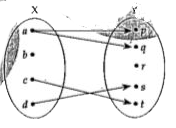Which of the following diagram represents axile placentation?




The correct Answer is:D
To determine which diagram represents axile placentation, we need to understand what placentation is and the different types of placentation found in flowering plants.
1. Understanding Placentation:
- Placentation refers to the arrangement of ovules within the ovary of a flower. It is crucial to identify the type of placentation to answer the question correctly.
2. Identifying Types of Placentation:
- There are several types of placentation, including:
- Basal Placentation: Ovules are attached at the base of the ovary.
- Free Central Placentation: Ovules are situated in the center of the ovary, with no septa dividing them.
- Parietal Placentation: Ovules are attached to the walls of the ovary.
- Axile Placentation: Ovules are attached to a central column (the placenta) in a multi-locular ovary.
3. Analyzing the Options:
- The first option represents Basal Placentation (wrong).
- The second option depicts Free Central Placentation (wrong).
- The third option shows Parietal Placentation (wrong).
- The fourth option illustrates Axile Placentation, characterized by multiple locules with ovules attached to a central axis (correct).
4. Conclusion:
- The correct answer is the last option, which represents axile placentation.
- Placentation refers to the arrangement of ovules within the ovary of a flower. It is crucial to identify the type of placentation to answer the question correctly.
- There are several types of placentation, including:
- Basal Placentation: Ovules are attached at the base of the ovary.
- Free Central Placentation: Ovules are situated in the center of the ovary, with no septa dividing them.
- Parietal Placentation: Ovules are attached to the walls of the ovary.
- Axile Placentation: Ovules are attached to a central column (the placenta) in a multi-locular ovary.
- The first option represents Basal Placentation (wrong).
- The second option depicts Free Central Placentation (wrong).
- The third option shows Parietal Placentation (wrong).
- The fourth option illustrates Axile Placentation, characterized by multiple locules with ovules attached to a central axis (correct).
- The correct answer is the last option, which represents axile placentation.
Topper's Solved these Questions
- MORPHOLOGY OF FLOWERING PLANTS BOOK - AAKASH SERIESCHAPTER - MORPHOLOGY OF FLOWERING PLANTS EXERCISE - EXERCISE - III (Previous AIPMT/NEET Questions)
41 Videos
- MORPHOLOGY OF FLOWERING PLANTS BOOK - AAKASH SERIESCHAPTER - MORPHOLOGY OF FLOWERING PLANTS EXERCISE - EXERCISE - I (Fruit)
66 Videos
- MICROBES IN HUMAN WELFARE BOOK - AAKASH SERIESCHAPTER - MICROBES IN HUMAN WELFARE EXERCISE - EXERCISE-III (Previous AIPMT/NEET Questions)
25 Videos
- REPRODUCTION IN ORGANISMSBOOK - AAKASH SERIESCHAPTER - REPRODUCTION IN ORGANISMSEXERCISE - Exercise-III (previous AIPMT/NEET Questions)
19 Videos
Similar Questions
Knowledge Check
Which of the following figures represents a typical placentation as seen in Hibiscus rosa sinensis (China rose)?
A B
B C
C D
D
Ellingham diagram represents:
AΔG with temperatureBΔH with temperatureCΔH with pressureD(ΔG−TΔS) with temperatureWhich of the following arrow diagrams represents a function from Xto Y?
A B
B C
C D
D
Which one of the following figures represents the placentation on primrose ?
View SolutionWhich of the following Venn diagram represent (A−B)?
View SolutionWhich of the following diagrams represent the veriation of electric field vector with time for a circularly polarised light
View SolutionThe voltage across a pure inductor is represented by the following diagram. Which one of the following diagrams will represent the current

View SolutionWhich of the following venn diagrams best represents the relationship between the following classes?
Spices, Cumin Seeds, Food
View Solution

